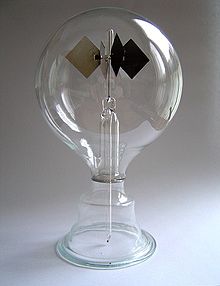
The Crookes radiometer (also known as a light mill) consists of an airtight glass bulb containing a partial vacuum, with a set of vanes which are mounted on a spindle inside. The vanes rotate when exposed to light, with faster rotation for more intense light, providing a quantitative measurement of electromagnetic radiation intensity.
The reason for the rotation was a cause of much scientific debate in the ten years following the invention of the device,[1][2] but in 1879 the currently accepted explanation for the rotation was published.[3][4] Today the device is mainly used in physics education as a demonstration of a heat engine run by light energy.
It was invented in 1873 by the chemist Sir William Crookes as the by-product of some chemical research. In the course of very accurate quantitative chemical work, he was weighing samples in a partially evacuated chamber to reduce the effect of air currents, and noticed the weighings were disturbed when sunlight shone on the balance. Investigating this effect, he created the device named after him.
It is still manufactured and sold as an educational aid or for curiosity.
- ^ Worrall, J. (1982). "The pressure of light: The strange case of the vacillating 'crucial experiment'". Studies in History and Philosophy of Science. 13 (2): 133–171. Bibcode:1982SHPSA..13..133W. doi:10.1016/0039-3681(82)90023-1.
- ^ The Electrical Engineer. Biggs & Company. 1888. p. 53.
- ^ Gibbs, Philip (1996). "How does a light-mill work?". math.ucr.edu/home/baez/physics/index.html. Usenet Physics FAQ. Retrieved 8 August 2014.
- ^ "Light-Mills discussion; The n-Category Cafe". Retrieved 29 April 2017.